Analysis of Crack-Characteristic Stress and Energy Characteristics of Sandstone under Triaxial Unloading Confining Pressure
Abstract
:1. Introduction
2. Test Conditions and Scheme
2.1. Test Conditions
2.2. Test Scheme
3. Analysis of Crack-Characteristic Stress
3.1. Calculation Method of Crack Strain
3.2. Analysis of Stress–Strain Curve
- (1)
- Compaction stage (o–σcc stage): the axial strain increases slowly and presents a concave growth. The growth of circumferential strain is small, almost zero. The volume strain trend and value are consistent with the axial strain. The volume strain of the crack gradually decreases to zero, and the primitive micro-cracks gradually close at this stage.
- (2)
- Linear elastic deformation stage (σcc–σci stage): the starting and ending positions correspond to the crack closure stress σcc and crack initiation stress σci, respectively. The axial strain increases linearly, the circumferential strain increases slightly, and the volumetric strain increases approximately linearly. The volumetric strain of the crack is zero. At this stage, the rock sample gradually compacts and begins to crack.
- (3)
- Steady crack growth stage (σci–σcd stage): when the crack initiation stress σci is exceeded, the axial strain still keeps a large growth rate, the growth rate of circumferential strain increases significantly, the volume strain increases slightly, reaching the maximum, and the volume strain of crack begins to increase. At this stage, rock sample cracks develop steadily and increase continuously.
- (4)
- Expansion cracking development stage (σcd–σp stage): when the dilatancy stress σcd is exceeded, the axial strain and circumferential strain increase stably, the volume strain deflects to the negative direction, the volume strain decreases rapidly, and the crack volume strain increases obviously. At this stage, the volumetric strain is reversed, the volume compression decreases obviously, and the rock samples enter the plastic yield stage.
- (5)
- Post peak stage (the stage after σp): when the peak stress σp is exceeded, almost axial strain, circumferential strain, and volume strain increase rapidly, crack volume strain also increases significantly, and the sample volume expands. The reason is the rapid development of internal cracks in rock samples, forming a large area of penetration, resulting in significant volume expansion; rock samples also undergo failure.
3.3. Analysis of Crack-Characteristic Stress
4. Analysis of Energy Evolution Characteristics of Triaxial Unloading Confining Sandstone
4.1. Energy Calculation Method
4.2. Energy Evolution Analysis
4.3. Analysis of Pre-Peak Energy Characteristics
4.4. Analysis of Post-Peak Energy Release Characteristics
5. Discussion
- (1)
- There is no description of crack morphology for the analysis of crack characteristic stress. For example, what is the crack morphology under the state of crack initiation stress? How is it distributed? Most of the research [29,30,31,32] obtained mechanical properties through indoor tests, and then used numerical simulation software to study the distribution law of crack morphology. In addition, the tests carried out in this study were limited; hence, the number and size of the test groups should be increased, and other unloading schemes should be investigated to supplement the unloading conditions. Therefore, experimental research on the distribution law of crack morphology will be one of the key points of follow-up research.
- (2)
- There is a lack of in-depth research on the characteristics of post-peak energy release. For example, the research process of released elastic energy after the peak stress can be discussed at the post-peak stage to study the characteristics of each energy release stage. In addition, the energy release is only analyzed from the view of axial strain, lacking a comprehensive analysis. It should also be analyzed over time to determine the time characteristics of energy release. These two aspects will be the focus of future research.
6. Conclusions
- When the confining pressure increased from 5 MPa to 20 MPa, the crack closure stress σcc, crack initiation stress σci, dilatancy stress σcd, and peak stress σp were 6.34 times, 2.75 times, 1.93 times, and 1.66 times higher than the original, respectively. By comparing the increase in characteristic stress, it was found that the confining pressure had a great influence on the crack closure stress and crack initiation stress, but relatively little influence on the dilatation stress and peak stress.
- Before the peak stress, the axial absorbed energy U1 increased exponentially, the elastic energy Ue was similar to U1, and the circumferential consumption energy U3 and dissipated energy Ud were small. After reaching the peak stress, the growth rate of U1 decreased slightly, Ue decreased rapidly, and U3 increased rapidly but only accounted for a small proportion of the total energy, while Ud grew almost exponentially and rapidly became the main part of the energy. Each energy eigenvalue increased linearly, reflecting an obvious confining pressure effect; axial absorption energy U1 increased the most, followed by elastic energy Ue, while annular consumption energy U3 increased the least, and dissipation energy Ud increased slightly more than U3.
- Under each crack-characteristic stress state, each energy characteristic parameter increased with the increase in confining pressure, as shown by the increase in slope in the linear fitting formula of the energy characteristic parameter. For example, the slope of the U1 fitting formula increased from 16.458 under the crack closure stress state to 42.149 under the peak stress state, indicating that the value of each energy characteristic parameter increased gradually before the peak stress, reflecting a strong confining pressure effect.
- The post-peak elastic energy release process could be divided into three stages: “slow–fast–slow”. In the first stage, the release rate was the slowest and the axial strain variation range was the smallest, at basically 0.05%. The second stage had the fastest release rate and the largest axial strain variation range. In the third stage, the release rate was slow, and the variation range of axial strain was small. The energy release process showed an obvious confining pressure effect.
Author Contributions
Funding
Institutional Review Board Statement
Informed Consent Statement
Data Availability Statement
Conflicts of Interest
References
- Li, Z.Y.; Wu, G.; Huang, T.Z.; Liu, Y. Variation of energy and criteria for strength failure of shale under triaxial cyclic loading. Chin. J. Rock Mech. Eng. 2018, 37, 662–670. [Google Scholar] [CrossRef]
- Gong, F.Q.; Yan, J.Y.; Li, X.B. A new criterion of rock burst proneness based on the linear energy storage law and the residual elastic energy index. J. Rock Mech. Eng. 2018, 37, 1993–2014. [Google Scholar] [CrossRef]
- Zou, Y.; Li, X.B.; Zhou, Z.L.; Yin, S.B.; Yin, Z.Q. Energy evolution and stress redistribution of high-stress rock mass under excavation distribution. Chin. J. Geotech. Eng. 2012, 34, 1677–1684. Available online: https://kns.cnki.net/kcms/detail/detail.aspx?FileName=YTGC201209022&DbName=CJFQ2012 (accessed on 20 January 2023).
- Xie, H.P.; Peng, R.D.; Ju, Y.; Zhou, H.W. On energy analysis of rock failure. Chin. J. Rock Mech. Eng. 2005, 24, 2603–2608. Available online: https://kns.cnki.net/kcms2/article/abstract?v=zHhSLvPVAV6xkzFI5oNl9F0GB7IatO6a25bFEzNl3rPGfCAoKtCAyrhAN_wNc8fauUijmGn3YtakOhAHEVceBFM94saIQXd7wQGyh-DBnDHcjEQo2drJeg==&uniplatform=NZKPT&language=CHS (accessed on 20 January 2023).
- Li, P.; Cai, M.F. Energy evolution mechanism and failure criteria of jointed surrounding rock under uniaxial compression. J. Cent. South Univ. 2021, 28, 1857–1874. Available online: https://kns.cnki.net/kcms/detail/detail.aspx?FileName=ZNGY202106020&DbName=CJFQ2021 (accessed on 20 January 2023). [CrossRef]
- Zhao, G.M.; Liu, Z.X.; Meng, X.R.; Zhang, R.F.; Kao, S.M.; Qi, M.J. Energy accumulation and dissipation test and height-diameter ratio sandstone analysis method. J. China Coal Soc. 2022, 47, 1110–1121. [Google Scholar] [CrossRef]
- Hou, L.; Cao, K.; Muhammad Khan, N.; Jahed Armaghani, D.; Alarifi, S.; Hussain, S.; Ali, M. Precursory Analysis of Water-Bearing Rock Fracture Based on The Proportion of Dissipated Energy. Sustainability 2023, 15, 1769. [Google Scholar] [CrossRef]
- Luo, J.; Wang, L. Study on Energy Evolution and Damage Constitutive Model of Sandstone under Cyclic Loading and Unloading. Appl. Sci. 2023, 13, 1690. [Google Scholar] [CrossRef]
- Zhang, L.M.; Gao, S.; Ren, M.Y.; Wang, Z.Q.; Ma, S.Q. Rock elastic strain energy and dissipation strain energy evolution characteristics under conventional triaxial compression. J. China Coal Soc. 2014, 39, 1238–1242. [Google Scholar] [CrossRef]
- Zhang, P.S.; Zhao, C.Y.; Li, T.H.; Hou, J.Q.; Gu, Q.H.; Zhang, R. Experimental study on wave velocity variation and energy evolution of red sandstone during triaxial loading process. Chin. J. Rock Mech. Eng. 2021, 40, 1369–1382. [Google Scholar] [CrossRef]
- Dai, B.; Zhao, G.Y.; Yang, C.; Dong, L.J. Energy evolution law of rocks in process of unloading failure under different paths. J. Min. Saf. Eng. 2016, 33, 367–374. [Google Scholar] [CrossRef]
- Yang, X.B.; Cheng, H.M.; Pei, Y.Y. Study on the evolution characteristics of rock deformation and post-peak energy under different loading methods. Chin. J. Rock Mech. Eng. 2020, 39, 3229–3236. [Google Scholar] [CrossRef]
- Meng, Q.B.; Zhang, M.W.; Zhang, Z.Z.; Han, L.J.; Pu, H. Research on non-linear characteristics of rock energy evolution under uniaxial cyclic loading and unloading conditions. Environ. Earth Sci. 2019, 78, 650. [Google Scholar] [CrossRef]
- Liu, B.; Chen, Y.; Lin, H.; Cao, R.; Zhang, S. Experimental Study on Shear Behavior of Rock Composite Material under Normal Unloading Conditions. Materials 2023, 16, 1233. [Google Scholar] [CrossRef]
- Liu, Z.X.; Zhao, G.M.; Meng, X.R.; Zhang, R.F.; Cheng, X.; Dong, C.L.; Huang, S.J. Analysis of creep energy evolution of red sandstone based on linear energy storage law. J. Cent. South Univ. Sci. Technol. 2021, 52, 2748–2760. Available online: https://kns.cnki.net/kcms/detail/detail.aspx?FileName=ZNGD202108021&DbName=CJFQ2021 (accessed on 20 January 2023).
- Zhang, X.P.; Wong, L.N.Y. Crack Initiation, Propagation and Coalescence in Rock-Like Material Containing Two Flaws: A Numerical Study Based on Bonded-Particle Model Approach. Rock Mech. Rock Eng. 2013, 46, 1001–1021. [Google Scholar] [CrossRef]
- Li, C.B.; Xie, H.P.; Xie, L.Z. Experimental and theoretical study on the shale crack initiation stress and crack damage stress. J. China Coal Soc. 2017, 42, 969–976. [Google Scholar] [CrossRef]
- Qin, T.; Duan, Y.W.; Sun, H.R.; Wang, L.; Liu, H.L. Mechanical characteristics and energy dissipation characteristics of sandstone under triaxial stress conditions. J. China Coal Soc. 2020, 45, 255–262. [Google Scholar] [CrossRef]
- Huang, S.L.; Zhong, P.J.; Ding, X.L. Study on characteristic strength anisotropy of layered chlorite schist under uniaxial compression. Chin. J. Rock Mech. Eng. 2021, 40, 3182–3190. [Google Scholar] [CrossRef]
- Zhang, Z.Z.; Gao, F. Confining pressure effect on rock energy. Chin. J. Rock Mech. Eng. 2015, 34, 1–11. [Google Scholar] [CrossRef]
- Dai, B.; Zhao, G.Y.; Konietzky, H.; Wasantha, P.L.P. Experimental investigation on damage evolution behaviour of a granitic rock under loading and unloading. J. Cent. South Univ. 2018, 25, 1213–1225. Available online: https://kns.cnki.net/kcms/detail/detail.aspx?FileName=ZNGY201805024&DbName=CJFQ2018 (accessed on 20 January 2023). [CrossRef]
- Zhao, Z.H.; Lu, R.; Zhang, G.Q. Analysis on energy transformation for rock in the whole process of deformation and fracture. Ming R D 2006, 05, 8–11. [Google Scholar] [CrossRef]
- Qin, T.; Duan, Y.W.; Sun, H.R.; Liu, H.L.; Wang, L. Energy Evolution and Acoustic Emission Characteristics of Sandstone Specimens under Unloading Confining Pressure. Shock Vib. 2019, 2019, 1612576. [Google Scholar] [CrossRef]
- Dong, X.J.; Ali, K.; Hakan, B.; Mohamed, E.; Abdennour, S. Energy Dissipation and Storage in Underground Mining Operations. Rock Mech. Rock Eng. 2019, 152, 229–245. [Google Scholar] [CrossRef]
- Yang, F.J.; Zhou, H.; Lu, J.J.; Zhang, C.Q.; Hu, D.W. An energy criterion in process of rockbrust. Chin. J. Rock Mech. Eng. 2015, 34, 2706–2714. [Google Scholar] [CrossRef]
- Zhang, Z.Z.; Gao, F. Experimental research on energy evolution of sandstone samples under uniaxial compression. Chin. J. Rock Mech. Eng. 2012, 31, 953–962. Available online: https://kns.cnki.net/kcms/detail/detail.aspx?FileName=YSLX201205013&DbName=CJFQ2012 (accessed on 20 January 2023). [CrossRef]
- Chen, Z.Q.; Li, T.B.; Chen, G.Q.; Ma, C.C. Experimental study on energy evolution of sandstone under different stress paths. Eng. Mech. 2016, 33, 120–128. Available online: https://kns.cnki.net/kcms/detail/detail.aspx?FileName=GCLX201606016&DbName=CJFQ2016 (accessed on 20 January 2023).
- Gao, S.; Zhang, L.M.; Wang, Z.Q.; Cong, Y. Study of deformation and energy properties of marble unloading failure. Chin. J. Rock Mech. Eng. 2014, 33, 2808–2813. [Google Scholar] [CrossRef]
- Li, J.T.; Liu, S.F.; Zhao, Y.; Guo, Q. True triaxial test and numerical simulation of sandstone in different stress paths. J. Cent. South Univ. Sci. Technol. 2021, 52, 693–700. Available online: https://kns.cnki.net/kcms/detail/detail.aspx?FileName=ZNGD202103004&DbName=CJFQ2021 (accessed on 20 January 2023).
- Wang, G.; Wang, R.; Wu, M.M.; Wang, P.F.; Zhou, Y.M. Simulation of conventional triaxial test on coal under hydro-mechanical coupling by particle flow code. Rock Soil Mech. 2016, 37, 537–546. [Google Scholar] [CrossRef]
- Tian, W.L.; Yang, S.Q.; Huang, Y.H.; Yin, P.F.; Zhu, Z.N.; Sun, B.W. Meso-fracture mechanism of granite specimens under high temperature and confining pressure by numerical simulation. Chin. J. Rock Mech. Eng. 2022, 41, 1810–1819. [Google Scholar] [CrossRef]
- Hang, M.Z.; Li, X.P.; Wang, G.; Liu, T.T.; Xu, K.C. Study on the Failure Characteristics of Single-Fissured Granite under Triaxial Compression Condition. Chin. J. Undergr. Space Eng. 2022, 18, 1208–1218. Available online: https://kns.cnki.net/kcms/detail/detail.aspx?FileName=BASE202204018&DbName=DKFX2022 (accessed on 20 January 2023).

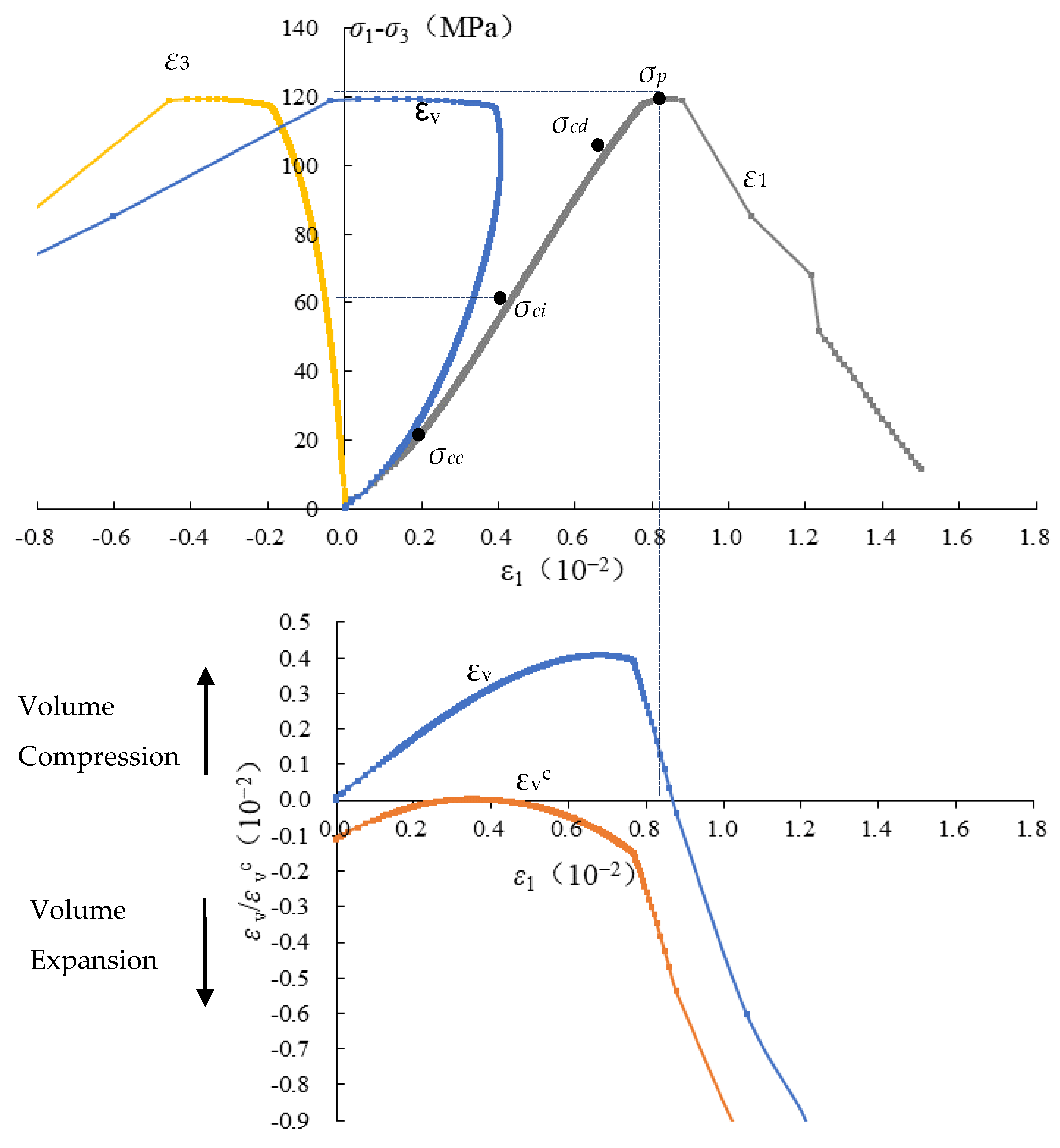
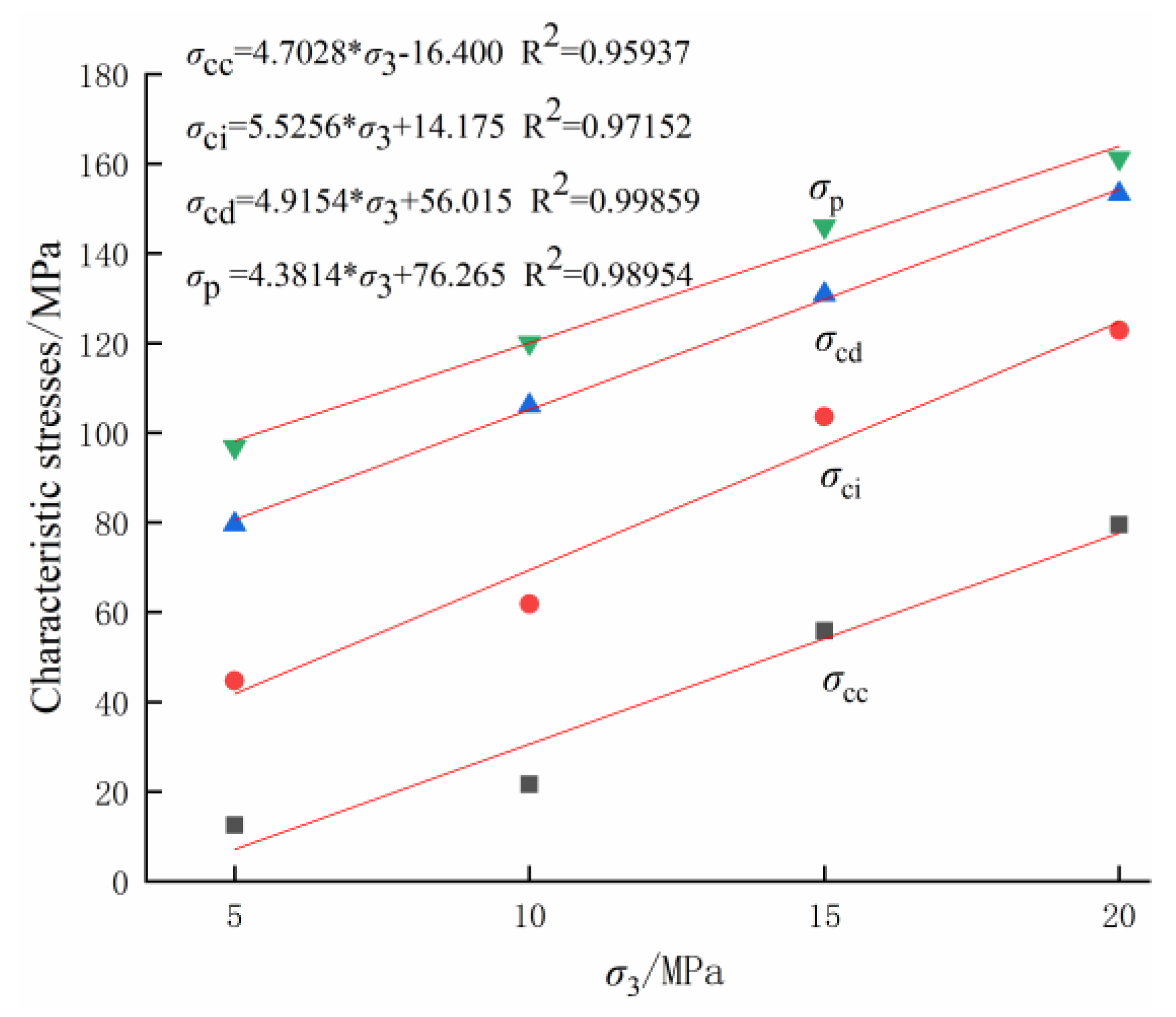
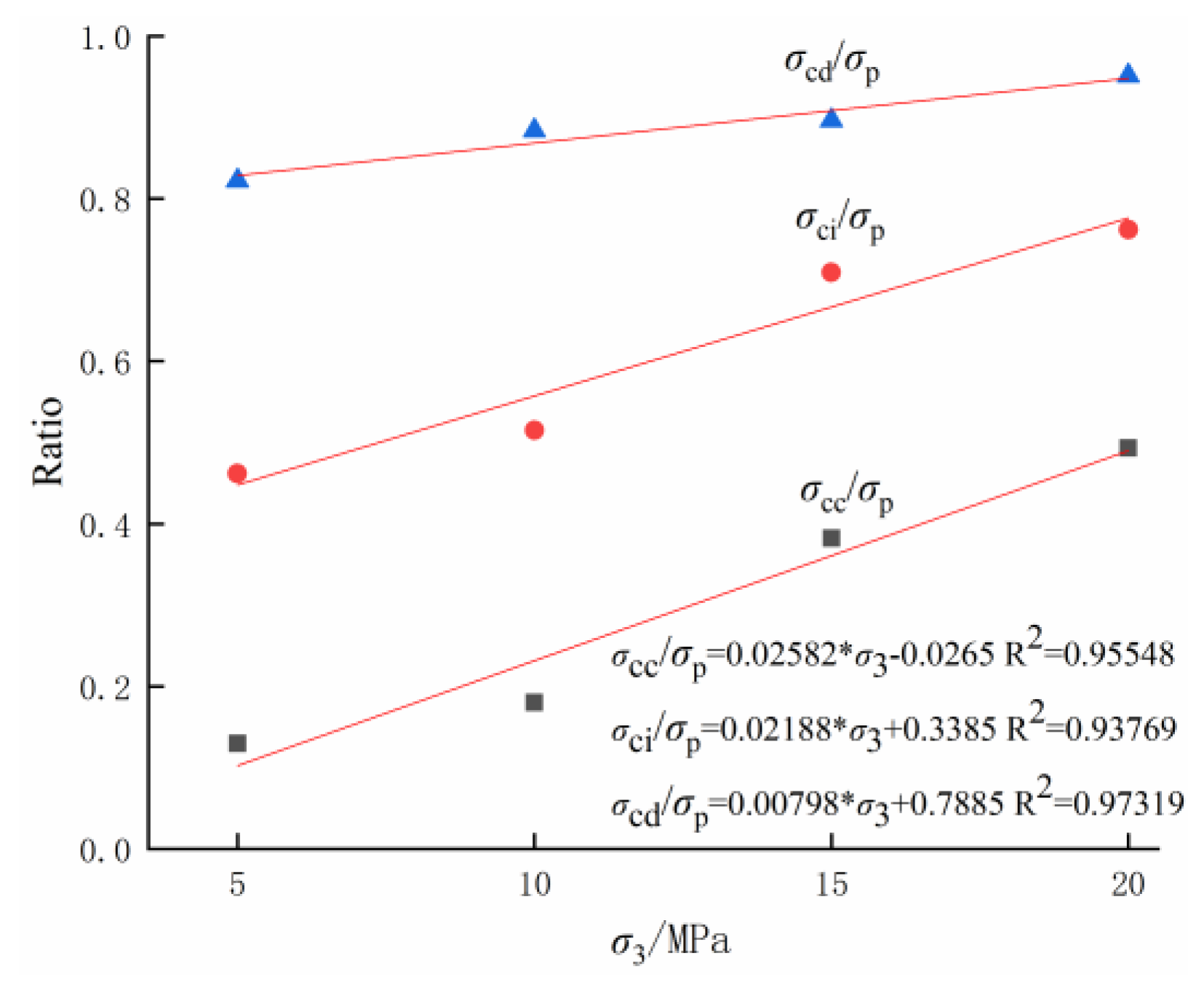
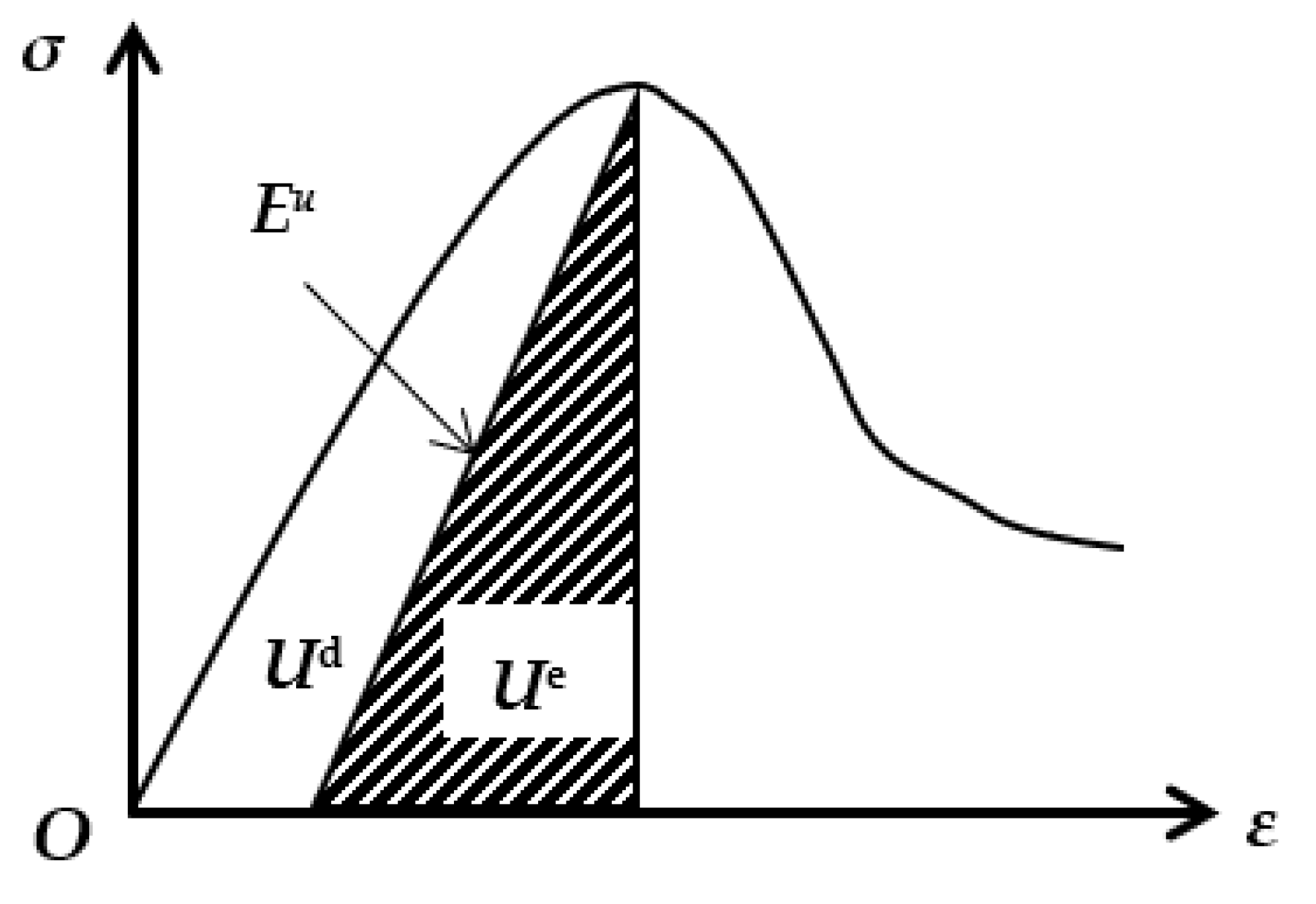
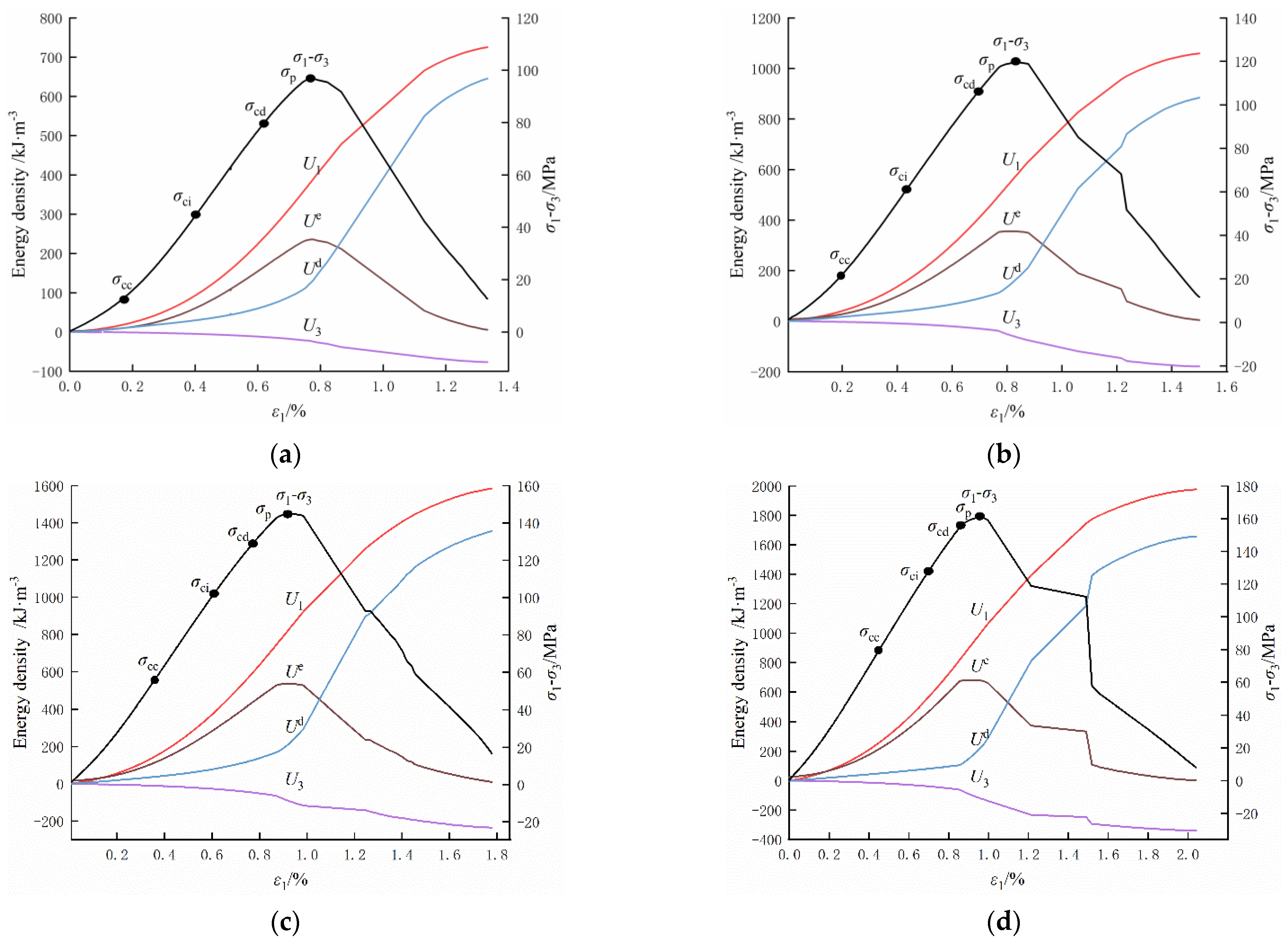
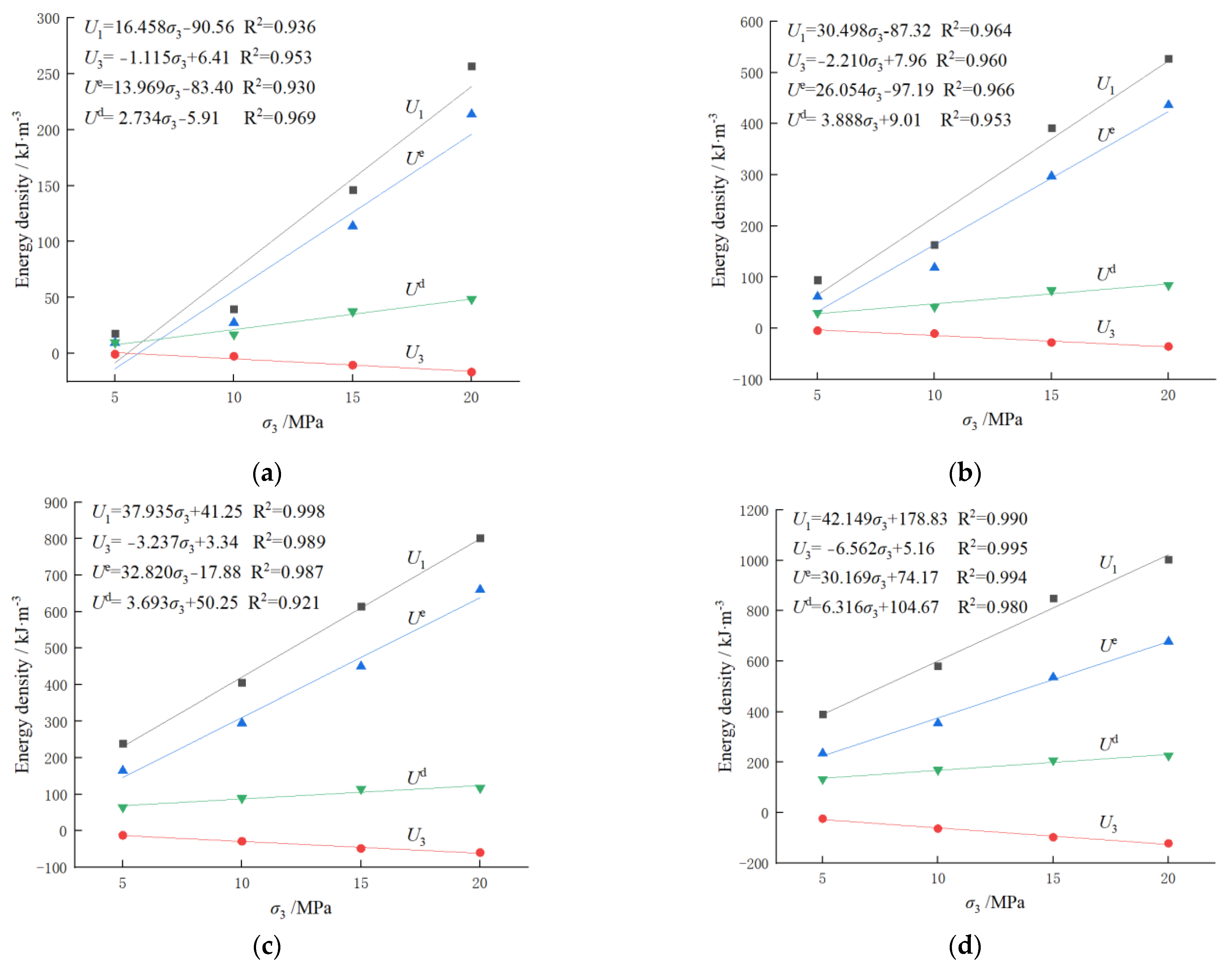
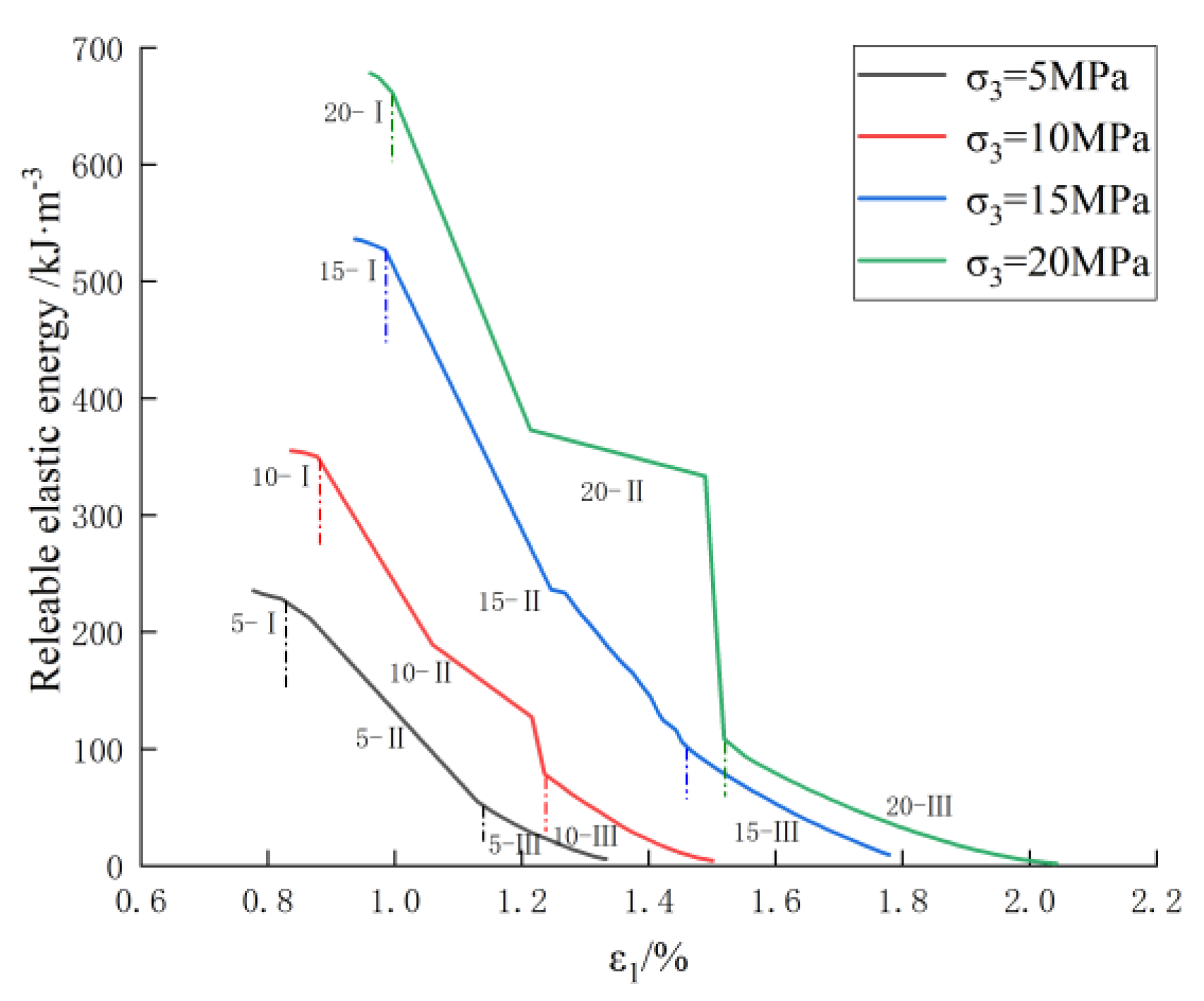
| Sample ID | Confining Pressure (MPa) | Peak Strength (MPa) |
|---|---|---|
| X1-1, X1-2, X1-3 | 5 | 96.86 |
| X2-1, X2-2, X2-3 | 10 | 120.02 |
| X3-1, X3-2, X3-3 | 15 | 146.04 |
| X4-1, X4-2, X4-3 | 20 | 161.21 |
| σ3 (MPa) | σcc (MPa) | σci (MPa) | σcd (MPa) | σp (MPa) | σcc (σp) | σci (σp) | σcd (σp) |
|---|---|---|---|---|---|---|---|
| 5 | 12.55 | 44.71 | 79.61 | 96.86 | 0.130 | 0.462 | 0.822 |
| 10 | 21.62 | 61.82 | 106.06 | 120.02 | 0.180 | 0.515 | 0.884 |
| 15 | 55.85 | 103.56 | 130.91 | 146.04 | 0.382 | 0.709 | 0.896 |
| 20 | 79.52 | 122.89 | 153.25 | 161.21 | 0.493 | 0.762 | 0.951 |
| Crack-Characteristic Stress | σ3 (MPa) | Energy Characteristic Parameters | |||
|---|---|---|---|---|---|
| U1 (kJ·m−3) | U3 (kJ·m−3) | Ue (kJ·m−3) | Ud (kJ·m−3) | ||
| σcc | 5 | 18.04 | −0.66 | 9.71 | 9.91 |
| 10 | 39.65 | −2.50 | 27.52 | 17.00 | |
| 15 | 146.13 | −10.33 | 113.89 | 37.53 | |
| 20 | 256.85 | −16.63 | 213.73 | 48.63 | |
| σci | 5 | 94.42 | −4.73 | 61.75 | 30.18 |
| 10 | 163.32 | −10.29 | 118.53 | 41.87 | |
| 15 | 391.10 | −27.92 | 297.26 | 74.19 | |
| 20 | 526.80 | −35.68 | 436.40 | 84.21 | |
| σcd | 5 | 239.16 | −12.44 | 164.59 | 64.36 |
| 10 | 405.93 | −28.90 | 295.16 | 89.25 | |
| 15 | 614.90 | −48.75 | 449.66 | 114.52 | |
| 20 | 801.76 | −59.78 | 660.09 | 117.48 | |
| σp | 5 | 390.47 | −24.25 | 235.59 | 132.87 |
| 10 | 580.21 | −63.26 | 355.21 | 169.12 | |
| 15 | 848.59 | −97.90 | 536.27 | 206.96 | |
| 20 | 1003.50 | −122.07 | 678.06 | 225.52 | |
Disclaimer/Publisher’s Note: The statements, opinions and data contained in all publications are solely those of the individual author(s) and contributor(s) and not of MDPI and/or the editor(s). MDPI and/or the editor(s) disclaim responsibility for any injury to people or property resulting from any ideas, methods, instructions or products referred to in the content. |
© 2023 by the authors. Licensee MDPI, Basel, Switzerland. This article is an open access article distributed under the terms and conditions of the Creative Commons Attribution (CC BY) license (https://creativecommons.org/licenses/by/4.0/).
Share and Cite
Duan, Y.; Zhang, G.; Qin, T. Analysis of Crack-Characteristic Stress and Energy Characteristics of Sandstone under Triaxial Unloading Confining Pressure. Appl. Sci. 2023, 13, 2671. https://doi.org/10.3390/app13042671
Duan Y, Zhang G, Qin T. Analysis of Crack-Characteristic Stress and Energy Characteristics of Sandstone under Triaxial Unloading Confining Pressure. Applied Sciences. 2023; 13(4):2671. https://doi.org/10.3390/app13042671
Chicago/Turabian StyleDuan, Yanwei, Guohua Zhang, and Tao Qin. 2023. "Analysis of Crack-Characteristic Stress and Energy Characteristics of Sandstone under Triaxial Unloading Confining Pressure" Applied Sciences 13, no. 4: 2671. https://doi.org/10.3390/app13042671





